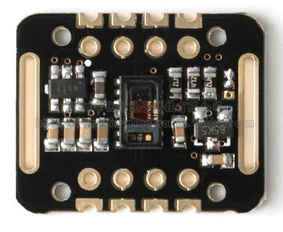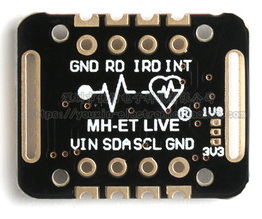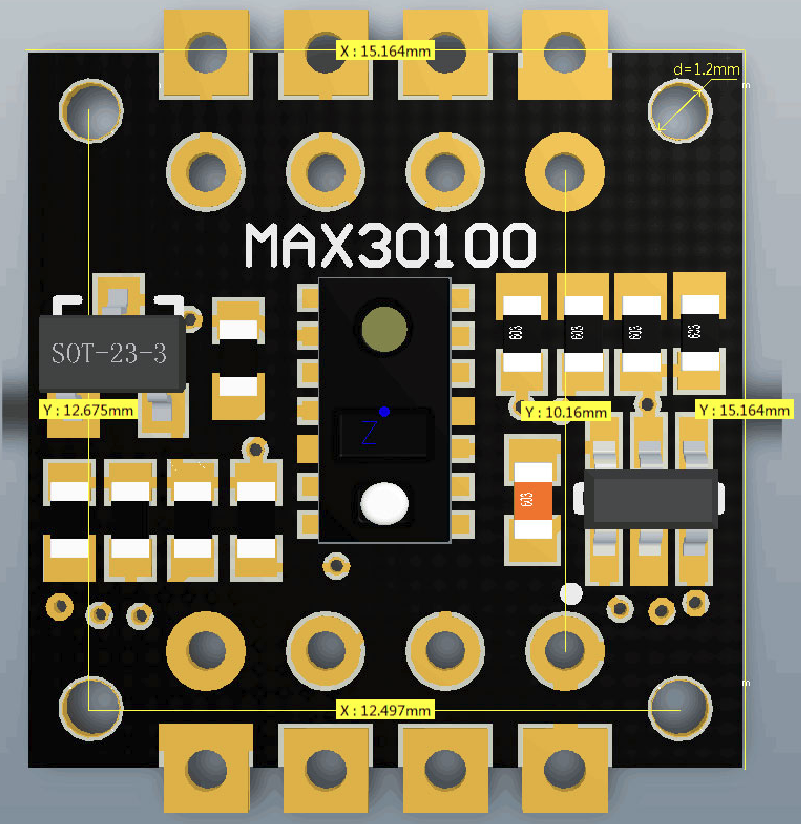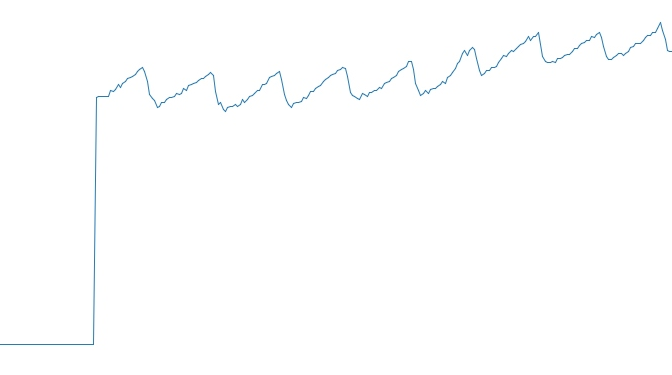电子模块|心率血氧传感器模块MAX30102及其驱动代码 实物照片模块简介工作原理原理图及引脚说明STM32软件驱动IIC通信代码数值转换代码main函数 结果 实物照片 模块简介


MAX30102是一个集成的脉搏血氧仪和心率监测仪生物传感器的模块。
它集成了一个红光LED和一个红外光LED、光电检测器、光器件,以及带环境光抑制的低噪声电子电路。
MAX30102采用一个1.8V电源和一个独立的5.0V用于内部LED的电源,应用于可穿戴设备进行心率和血氧采集检测,佩戴于手指点耳垂和手腕处。
标准的I2C兼容的通信接口可以将采集到的数值传输给Arduino、KL25Z、STM32、STC51等单片机进行心率和血氧计算。
此外,该芯片还可以通过软件关断模块,待机电流接近为零,实现电源始终维持供电状态。
主要参数:
| 产品名称 | MAX30102 心率模块 |
|---|---|
| LED峰值波长器 | 660nm/880nm |
| LED供电电压 | 3.3 ~ 5V |
| 检测信号类型 | 光反射信号(PPG) |
| 输出信号接口 | I2C接口 |
| 通信接口电压 | 1.8 ~ 3.3V ~ 5V(可选) |
产品尺寸:

光溶积法:利用人体组织在血管搏动时造成透光率不同来进行脉搏和血氧饱和度测量
光源:采用对动脉血中痒合血红蛋白(HbO2)和血红蛋白(Hb)有选择性的特定波长的发光二极管
透光率转化为电信号:动脉搏动充血容积变化导致这束光的透光率发送改变,此时由光电变换接收经人体组织反射光线,转变为电信号并将其放大输出。



引脚说明
| 名称 | 管教定义 |
|---|---|
| VIN | 电源输入 1.6V-5.5V |
| 3位焊盘 | 选择总线的上拉电平,取决于引脚主控电压可选1.8v或者3.3v |
| SDA | IIC-SDA |
| SCL | IIC-SCL |
| GND | 地 |
| INT | INT 低电平有效中断(漏极开路)MAX30102 的中断引脚 |
| IRD | IR_DRV IR LED阴极和LED驱动器连接点 一般不接 |
| RD | R_DRV 红色LED阴极和LED驱动器连接点 一般不接 |
使用STM32F103C8T6最小系统开发板验证。
接线如下:
MAX30102模块接口:PB9-SDA,PB8-SCL,PB7-INT
PA2/PA3为串口传输口TX和RX,波特率设置为115200
PC13为显示LED
#include "mbed.h"#include "MAX30102.h"I2C i2c(I2C_SDA, I2C_SCL);//SDA-PB9,SCL-PB8bool maxim_max30102_write_reg(uint8_t uch_addr, uint8_t uch_data){ char ach_i2c_data[2]; ach_i2c_data[0]=uch_addr; ach_i2c_data[1]=uch_data; if(i2c.write(I2C_WRITE_ADDR, ach_i2c_data, 2, false)==0) return true; else return false;}bool maxim_max30102_read_reg(uint8_t uch_addr, uint8_t *puch_data){ char ch_i2c_data; ch_i2c_data=uch_addr; if(i2c.write(I2C_WRITE_ADDR, &ch_i2c_data, 1, true)!=0) return false; if(i2c.read(I2C_READ_ADDR, &ch_i2c_data, 1, false)==0) { *puch_data=(uint8_t) ch_i2c_data; return true; } else return false;}bool maxim_max30102_init(){ if(!maxim_max30102_write_reg(REG_INTR_ENABLE_1,0xc0)) // INTR setting return false; if(!maxim_max30102_write_reg(REG_INTR_ENABLE_2,0x00)) return false; if(!maxim_max30102_write_reg(REG_FIFO_WR_PTR,0x00)) //FIFO_WR_PTR[4:0] return false; if(!maxim_max30102_write_reg(REG_OVF_COUNTER,0x00)) //OVF_COUNTER[4:0] return false; if(!maxim_max30102_write_reg(REG_FIFO_RD_PTR,0x00)) //FIFO_RD_PTR[4:0] return false; if(!maxim_max30102_write_reg(REG_FIFO_CONFIG,0x0f)) //sample avg = 1, fifo rollover=false, fifo almost full = 17 return false; if(!maxim_max30102_write_reg(REG_MODE_CONFIG,0x03)) //0x02 for Red only, 0x03 for SpO2 mode 0x07 multimode LED return false; if(!maxim_max30102_write_reg(REG_SPO2_CONFIG,0x27)) // SPO2_ADC range = 4096nA, SPO2 sample rate (100 Hz), LED pulseWidth (400uS) return false; if(!maxim_max30102_write_reg(REG_LED1_PA,0x24)) //Choose value for ~ 7mA for LED1 return false; if(!maxim_max30102_write_reg(REG_LED2_PA,0x24)) // Choose value for ~ 7mA for LED2 return false; if(!maxim_max30102_write_reg(REG_PILOT_PA,0x7f)) // Choose value for ~ 25mA for Pilot LED return false; return true; }bool maxim_max30102_read_fifo(uint32_t *pun_red_led, uint32_t *pun_ir_led){ uint32_t un_temp; unsigned char uch_temp; *pun_red_led=0; *pun_ir_led=0; char ach_i2c_data[6]; //read and clear status reGISter maxim_max30102_read_reg(REG_INTR_STATUS_1, &uch_temp); maxim_max30102_read_reg(REG_INTR_STATUS_2, &uch_temp); ach_i2c_data[0]=REG_FIFO_DATA; if(i2c.write(I2C_WRITE_ADDR, ach_i2c_data, 1, true)!=0) return false; if(i2c.read(I2C_READ_ADDR, ach_i2c_data, 6, false)!=0) { return false; } un_temp=(unsigned char) ach_i2c_data[0]; un_temp<<=16; *pun_red_led+=un_temp; un_temp=(unsigned char) ach_i2c_data[1]; un_temp<<=8; *pun_red_led+=un_temp; un_temp=(unsigned char) ach_i2c_data[2]; *pun_red_led+=un_temp; un_temp=(unsigned char) ach_i2c_data[3]; un_temp<<=16; *pun_ir_led+=un_temp; un_temp=(unsigned char) ach_i2c_data[4]; un_temp<<=8; *pun_ir_led+=un_temp; un_temp=(unsigned char) ach_i2c_data[5]; *pun_ir_led+=un_temp; *pun_red_led&=0x03FFFF; //Mask MSB [23:18] *pun_ir_led&=0x03FFFF; //Mask MSB [23:18] return true;}bool maxim_max30102_reset(){ if(!maxim_max30102_write_reg(REG_MODE_CONFIG,0x40)) return false; else return true; }#include "alGorithm.h"#include "mbed.h"void maxim_heart_rate_and_oxygen_saturation(uint32_t *pun_ir_buffer, int32_t n_ir_buffer_length, uint32_t *pun_red_buffer, int32_t *pn_spo2, int8_t *pch_spo2_valid, int32_t *pn_heart_rate, int8_t *pch_hr_valid){ uint32_t un_ir_mean ,un_only_once ; int32_t k ,n_i_ratio_count; int32_t i, s, m, n_exact_ir_valley_locs_count ,n_middle_idx; int32_t n_th1, n_npks,n_c_min; int32_t an_ir_valley_locs[15] ; int32_t an_exact_ir_valley_locs[15] ; int32_t an_dx_peak_locs[15] ; int32_t n_peak_interval_sum; int32_t n_y_ac, n_x_ac; int32_t n_spo2_calc; int32_t n_y_dc_max, n_x_dc_max; int32_t n_y_dc_max_idx, n_x_dc_max_idx; int32_t an_ratio[5],n_ratio_average; int32_t n_nume, n_denom ; // remove DC of ir signal un_ir_mean =0; for (k=0 ; k<n_ir_buffer_length ; k++ ) un_ir_mean += pun_ir_buffer[k] ; un_ir_mean =un_ir_mean/n_ir_buffer_length ; for (k=0 ; k<n_ir_buffer_length ; k++ ) an_x[k] = pun_ir_buffer[k] - un_ir_mean ; // 4 pt Moving Average for(k=0; k< BUFFER_SIZE-MA4_SIZE; k++){ n_denom= ( an_x[k]+an_x[k+1]+ an_x[k+2]+ an_x[k+3]); an_x[k]= n_denom/(int32_t)4; } // get difference of smoothed IR signal for( k=0; k<BUFFER_SIZE-MA4_SIZE-1; k++) an_dx[k]= (an_x[k+1]- an_x[k]); // 2-pt Moving Average to an_dx for(k=0; k< BUFFER_SIZE-MA4_SIZE-2; k++){ an_dx[k] = ( an_dx[k]+an_dx[k+1])/2 ; } // hamming window // flip wave fORM so that we can detect valley with peak detector for ( i=0 ; i<BUFFER_SIZE-HAMMING_SIZE-MA4_SIZE-2 ;i++){ s= 0; for( k=i; k<i+ HAMMING_SIZE ;k++){ s -= an_dx[k] *auw_hamm[k-i] ; } an_dx[i]= s/ (int32_t)1146; // divide by sum of auw_hamm } n_th1=0; // threshold calculation for ( k=0 ; k<BUFFER_SIZE-HAMMING_SIZE ;k++){ n_th1 += ((an_dx[k]>0)? an_dx[k] : ((int32_t)0-an_dx[k])) ; } n_th1= n_th1/ ( BUFFER_SIZE-HAMMING_SIZE); // peak location is acutally index for sharpest location of raw signal since we flipped the signal maxim_find_peaks( an_dx_peak_locs, &n_npks, an_dx, BUFFER_SIZE-HAMMING_SIZE, n_th1, 8, 5 );//peak_height, peak_distance, max_num_peaks n_peak_interval_sum =0; if (n_npks>=2){ for (k=1; k<n_npks; k++) n_peak_interval_sum += (an_dx_peak_locs[k]-an_dx_peak_locs[k -1]); n_peak_interval_sum=n_peak_interval_sum/(n_npks-1); *pn_heart_rate=(int32_t)(6000/n_peak_interval_sum);// beats per minutes *pch_hr_valid = 1; } else { *pn_heart_rate = -999; *pch_hr_valid = 0; } for ( k=0 ; k<n_npks ;k++) an_ir_valley_locs[k]=an_dx_peak_locs[k]+HAMMING_SIZE/2; // raw value : RED(=y) and IR(=X) // we need to assess DC and AC value of ir and red PPG. for (k=0 ; k<n_ir_buffer_length ; k++ ) { an_x[k] = pun_ir_buffer[k] ; an_y[k] = pun_red_buffer[k] ; } // find precise min near an_ir_valley_locs n_exact_ir_valley_locs_count =0; for(k=0 ; k<n_npks ;k++){ un_only_once =1; m=an_ir_valley_locs[k]; n_c_min= 16777216;//2^24; if (m+5 < BUFFER_SIZE-HAMMING_SIZE && m-5 >0){ for(i= m-5;i<m+5; i++) if (an_x[i]<n_c_min){ if (un_only_once >0){ un_only_once =0; } n_c_min= an_x[i] ; an_exact_ir_valley_locs[k]=i; } if (un_only_once ==0) n_exact_ir_valley_locs_count ++ ; } } if (n_exact_ir_valley_locs_count <2 ){ *pn_spo2 = -999 ; // do not use SPO2 since signal ratio is out of range *pch_spo2_valid = 0; return; } // 4 pt MA for(k=0; k< BUFFER_SIZE-MA4_SIZE; k++){ an_x[k]=( an_x[k]+an_x[k+1]+ an_x[k+2]+ an_x[k+3])/(int32_t)4; an_y[k]=( an_y[k]+an_y[k+1]+ an_y[k+2]+ an_y[k+3])/(int32_t)4; } //using an_exact_ir_valley_locs , find ir-red DC andir-red AC for SPO2 calibration ratio //finding AC/DC maximum of raw ir * red between two valley locations n_ratio_average =0; n_i_ratio_count =0; for(k=0; k< 5; k++) an_ratio[k]=0; for (k=0; k< n_exact_ir_valley_locs_count; k++){ if (an_exact_ir_valley_locs[k] > BUFFER_SIZE ){ *pn_spo2 = -999 ; // do not use SPO2 since valley loc is out of range *pch_spo2_valid = 0; return; } } // find max between two valley locations // and use ratio betwen AC compoent of Ir & Red and DC compoent of Ir & Red for SPO2 for (k=0; k< n_exact_ir_valley_locs_count-1; k++){ n_y_dc_max= -16777216 ; n_x_dc_max= - 16777216; if (an_exact_ir_valley_locs[k+1]-an_exact_ir_valley_locs[k] >10){ for (i=an_exact_ir_valley_locs[k]; i< an_exact_ir_valley_locs[k+1]; i++){ if (an_x[i]> n_x_dc_max) {n_x_dc_max =an_x[i];n_x_dc_max_idx =i; } if (an_y[i]> n_y_dc_max) {n_y_dc_max =an_y[i];n_y_dc_max_idx=i;} } n_y_ac= (an_y[an_exact_ir_valley_locs[k+1]] - an_y[an_exact_ir_valley_locs[k] ] )*(n_y_dc_max_idx -an_exact_ir_valley_locs[k]); //red n_y_ac= an_y[an_exact_ir_valley_locs[k]] + n_y_ac/ (an_exact_ir_valley_locs[k+1] - an_exact_ir_valley_locs[k]) ; n_y_ac= an_y[n_y_dc_max_idx] - n_y_ac; // subracting linear DC compoenents from raw n_x_ac= (an_x[an_exact_ir_valley_locs[k+1]] - an_x[an_exact_ir_valley_locs[k] ] )*(n_x_dc_max_idx -an_exact_ir_valley_locs[k]); // ir n_x_ac= an_x[an_exact_ir_valley_locs[k]] + n_x_ac/ (an_exact_ir_valley_locs[k+1] - an_exact_ir_valley_locs[k]); n_x_ac= an_x[n_y_dc_max_idx] - n_x_ac; // subracting linear DC compoenents from raw n_nume=( n_y_ac *n_x_dc_max)>>7 ; //prepare X100 to preserve floating value n_denom= ( n_x_ac *n_y_dc_max)>>7; if (n_denom>0 && n_i_ratio_count <5 && n_nume != 0) { an_ratio[n_i_ratio_count]= (n_nume*100)/n_denom ; //formular is ( n_y_ac *n_x_dc_max) / ( n_x_ac *n_y_dc_max) ; n_i_ratio_count++; } } } maxim_sort_ascend(an_ratio, n_i_ratio_count); n_middle_idx= n_i_ratio_count/2; if (n_middle_idx >1) n_ratio_average =( an_ratio[n_middle_idx-1] +an_ratio[n_middle_idx])/2; // use median else n_ratio_average = an_ratio[n_middle_idx ]; if( n_ratio_average>2 && n_ratio_average <184){ n_spo2_calc= uch_spo2_table[n_ratio_average] ; *pn_spo2 = n_spo2_calc ; *pch_spo2_valid = 1;// float_SPO2 = -45.060*n_ratio_average* n_ratio_average/10000 + 30.354 *n_ratio_average/100 + 94.845 ; // for comparison with table } else{ *pn_spo2 = -999 ; // do not use SPO2 since signal ratio is out of range *pch_spo2_valid = 0; }}void maxim_find_peaks(int32_t *pn_locs, int32_t *pn_npks, int32_t *pn_x, int32_t n_size, int32_t n_min_height, int32_t n_min_distance, int32_t n_max_num){ maxim_peaks_above_min_height( pn_locs, pn_npks, pn_x, n_size, n_min_height ); maxim_remove_close_peaks( pn_locs, pn_npks, pn_x, n_min_distance ); *pn_npks = min( *pn_npks, n_max_num );}void maxim_peaks_above_min_height(int32_t *pn_locs, int32_t *pn_npks, int32_t *pn_x, int32_t n_size, int32_t n_min_height){ int32_t i = 1, n_width; *pn_npks = 0; while (i < n_size-1){ if (pn_x[i] > n_min_height && pn_x[i] > pn_x[i-1]){ // find left edge of potential peaks n_width = 1; while (i+n_width < n_size && pn_x[i] == pn_x[i+n_width]) // find flat peaks n_width++; if (pn_x[i] > pn_x[i+n_width] && (*pn_npks) < 15 ){// find right edge of peaks pn_locs[(*pn_npks)++] = i; // for flat peaks, peak location is left edge i += n_width+1; } else i += n_width; } else i++; }}void maxim_remove_close_peaks(int32_t *pn_locs, int32_t *pn_npks, int32_t *pn_x, int32_t n_min_distance){ int32_t i, j, n_old_npks, n_dist; maxim_sort_indices_descend( pn_x, pn_locs, *pn_npks ); for ( i = -1; i < *pn_npks; i++ ){ n_old_npks = *pn_npks; *pn_npks = i+1; for ( j = i+1; j < n_old_npks; j++ ){ n_dist = pn_locs[j] - ( i == -1 ? -1 : pn_locs[i] ); // lag-zero peak of autocorr is at index -1 if ( n_dist > n_min_distance || n_dist < -n_min_distance ) pn_locs[(*pn_npks)++] = pn_locs[j]; } } // Resort indices longo ascending order maxim_sort_ascend( pn_locs, *pn_npks );}void maxim_sort_ascend(int32_t *pn_x,int32_t n_size) { int32_t i, j, n_temp; for (i = 1; i < n_size; i++) { n_temp = pn_x[i]; for (j = i; j > 0 && n_temp < pn_x[j-1]; j--) pn_x[j] = pn_x[j-1]; pn_x[j] = n_temp; }}void maxim_sort_indices_descend(int32_t *pn_x, int32_t *pn_indx, int32_t n_size) { int32_t i, j, n_temp; for (i = 1; i < n_size; i++) { n_temp = pn_indx[i]; for (j = i; j > 0 && pn_x[n_temp] > pn_x[pn_indx[j-1]]; j--) pn_indx[j] = pn_indx[j-1]; pn_indx[j] = n_temp; }}#include "stm32f103c8t6.h"#include "mbed.h"#include "algorithm.h"#include "MAX30102.h"#define MAX_BRIGHTNESS 255uint32_t aun_ir_buffer[500]; //IR LED sensor dataint32_t n_ir_buffer_length; //data lengthuint32_t aun_red_buffer[500]; //Red LED sensor dataint32_t n_sp02; //SPO2 valueint8_t ch_spo2_valid; //indicator to show if the SP02 calculation is validint32_t n_heart_rate; //heart rate valueint8_t ch_hr_valid; //indicator to show if the heart rate calculation is validuint8_t uch_dummy;Serial pc(SERIAL_TX, SERIAL_RX); //initializes the serial port, TX-PA2, RX-PA3PwmOut pwmled(PB_3); //initializes the pwm output PB3 that connects to the LEDDigitalIn INT(PB_7); //pin PB7 connects to the interrupt output pin of the MAX30102DigitalOut led(PC_13); //PC13 connects to the on board user LED// the setup routine runs once when you press reset:int main() { uint32_t un_min, un_max, un_prev_data; //variables to calculate the on-board LED brightness that reflects the heartbeats int i; int32_t n_brightness; float f_temp; maxim_max30102_reset(); //resets the MAX30102 // initialize serial communication at 115200 bits per second: pc.baud(115200); pc.format(8,SerialBase::None,1); wait(1); //read and clear status register maxim_max30102_read_reg(0,&uch_dummy); //wait until the user presses a key// while(pc.readable()==0)// {// pc.printf("\x1B[2J"); //clear terminal program screen// pc.printf("Press any key to start conversion\n\r");// wait(1);// }// uch_dummy=getchar(); maxim_max30102_init(); //initializes the MAX30102 n_brightness=0; un_min=0x3FFFF; un_max=0; n_ir_buffer_length=500; //buffer length of 100 stores 5 seconds of samples running at 100sps //read the first 500 samples, and determine the signal range for(i=0;i<n_ir_buffer_length;i++) { while(INT.read()==1); //wait until the interrupt pin asserts maxim_max30102_read_fifo((aun_red_buffer+i), (aun_ir_buffer+i)); //read from MAX30102 FIFO if(un_min>aun_red_buffer[i]) un_min=aun_red_buffer[i]; //update signal min if(un_max<aun_red_buffer[i]) un_max=aun_red_buffer[i]; //update signal max pc.printf("red="); pc.printf("%i", aun_red_buffer[i]); pc.printf(", ir="); pc.printf("%i\n\r", aun_ir_buffer[i]); } un_prev_data=aun_red_buffer[i]; //calculate heart rate and SpO2 after first 500 samples (first 5 seconds of samples) maxim_heart_rate_and_oxygen_saturation(aun_ir_buffer, n_ir_buffer_length, aun_red_buffer, &n_sp02, &ch_spo2_valid, &n_heart_rate, &ch_hr_valid); //Continuously taking samples from MAX30102. Heart rate and SpO2 are calculated every 1 second while(1) { i=0; un_min=0x3FFFF; un_max=0; //dumping the first 100 sets of samples in the memory and shift the last 400 sets of samples to the top for(i=100;i<500;i++) { aun_red_buffer[i-100]=aun_red_buffer[i]; aun_ir_buffer[i-100]=aun_ir_buffer[i]; //update the signal min and max if(un_min>aun_red_buffer[i]) un_min=aun_red_buffer[i]; if(un_max<aun_red_buffer[i]) un_max=aun_red_buffer[i]; } //take 100 sets of samples before calculating the heart rate. for(i=400;i<500;i++) { un_prev_data=aun_red_buffer[i-1]; while(INT.read()==1); maxim_max30102_read_fifo((aun_red_buffer+i), (aun_ir_buffer+i)); if(aun_red_buffer[i]>un_prev_data)//just to determine the brightness of LED according to the deviation of adjacent two AD data { f_temp=aun_red_buffer[i]-un_prev_data; f_temp/=(un_max-un_min); f_temp*=MAX_BRIGHTNESS; n_brightness-=(int)f_temp; if(n_brightness<0) n_brightness=0; } else { f_temp=un_prev_data-aun_red_buffer[i]; f_temp/=(un_max-un_min); f_temp*=MAX_BRIGHTNESS; n_brightness+=(int)f_temp; if(n_brightness>MAX_BRIGHTNESS) n_brightness=MAX_BRIGHTNESS; } pwmled.write(1-(float)n_brightness/256);//pwm control led brightnessif(n_brightness<120)led=1;elseled=0; //send samples and calculation result to terminal program through UART pc.printf("red="); pc.printf("%i", aun_red_buffer[i]); pc.printf(", ir="); pc.printf("%i", aun_ir_buffer[i]); pc.printf(", HR=%i, ", n_heart_rate); pc.printf("HRvalid=%i, ", ch_hr_valid); pc.printf("SpO2=%i, ", n_sp02); pc.printf("SPO2Valid=%i\n\r", ch_spo2_valid); } maxim_heart_rate_and_oxygen_saturation(aun_ir_buffer, n_ir_buffer_length, aun_red_buffer, &n_sp02, &ch_spo2_valid, &n_heart_rate, &ch_hr_valid); }}将输出数据转成曲线

来源地址:https://blog.csdn.net/qq_32761549/article/details/128573054
--结束END--
本文标题: 电子模块|心率血氧传感器模块MAX30102及其驱动代码
本文链接: https://www.lsjlt.com/news/393062.html(转载时请注明来源链接)
有问题或投稿请发送至: 邮箱/279061341@qq.com QQ/279061341
下载Word文档到电脑,方便收藏和打印~
2024-02-29
2024-02-29
2024-02-29
2024-02-29
2024-02-29
2024-02-29
2024-02-29
2024-02-29
2024-02-29
2024-02-29
回答
回答
回答
回答
回答
回答
回答
回答
回答
回答
0